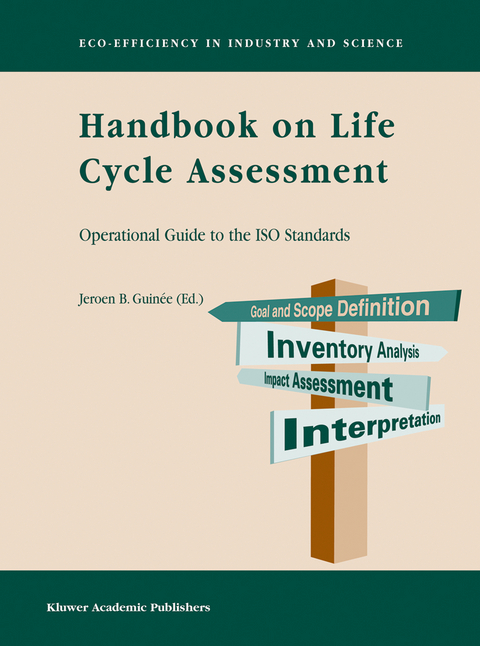
Handbook on Life Cycle Assessment
Operational Guide to the ISO Standards
Seiten
2002
Springer-Verlag New York Inc.
978-1-4020-0557-2 (ISBN)
Springer-Verlag New York Inc.
978-1-4020-0557-2 (ISBN)
New developments in LCA methodology from all over the world have been discussed and, where possible, included in this new Handbook. The thinking on environment and sustainability is, however, quickly evolving so that it is already clear now that this new LCA Handbook does not embrace the very latest developments.
Environmental policy aims at the transition to sustainable production and consumption. This is taking place in different ways and at different levels. In cases where businesses are continuously active to improve the environmental performance of their products and activities, the availability of knowledge on environmental impacts is indispensable. The integrated assessment of all environmental impacts from cradle to grave is the basis for many decisions relating to achieving improved products and services. The assessment tool most widely used for this is the environmental Life Cycle Assessment, or LCA. Before you is the new Handbook of LCA replacing the previous edition of 1992. New developments in LCA methodology from all over the world have been discussed and, where possible, included in this new Handbook. Integration of all developments into a new, consistent method has been the main aim for the new Handbook. The thinking on environment and sustainability is, however, quickly evolving so that it is already clear now that this new LCA Handbook does not embrace the very latest developments. Therefore, further revisions will have to take place in the future. A major advantage of this Handbook is that it now also advises which procedures should be followed to achieve adequate, relevant and accepted results. Furthermore, the distinction between detailed and simplified LCA makes this Handbook more broadly applicable, while guidance is provided as to which additional information can be relevant for specialised applications.
Environmental policy aims at the transition to sustainable production and consumption. This is taking place in different ways and at different levels. In cases where businesses are continuously active to improve the environmental performance of their products and activities, the availability of knowledge on environmental impacts is indispensable. The integrated assessment of all environmental impacts from cradle to grave is the basis for many decisions relating to achieving improved products and services. The assessment tool most widely used for this is the environmental Life Cycle Assessment, or LCA. Before you is the new Handbook of LCA replacing the previous edition of 1992. New developments in LCA methodology from all over the world have been discussed and, where possible, included in this new Handbook. Integration of all developments into a new, consistent method has been the main aim for the new Handbook. The thinking on environment and sustainability is, however, quickly evolving so that it is already clear now that this new LCA Handbook does not embrace the very latest developments. Therefore, further revisions will have to take place in the future. A major advantage of this Handbook is that it now also advises which procedures should be followed to achieve adequate, relevant and accepted results. Furthermore, the distinction between detailed and simplified LCA makes this Handbook more broadly applicable, while guidance is provided as to which additional information can be relevant for specialised applications.
LCA in Perspective.- Why a new Guide to LCA?.- Main characteristics of LCA.- International developments.- Guiding principles for the present Guide.- Reading guide.- Guide.- Management of LCA projects: procedures.- Goal and scope definition.- Inventory analysis.- Impact assessment.- Interpretation.- Operational Annex.- Management of LCA projects: procedures.- Goal and scope definition.- Inventory analysis.- Impact assessment.- Interpretation.- References.- Scientific Background.- General introduction.- Goal and scope definition.- Inventory analysis.- Impact assessment.- Interpretation.- References.
| Erscheint lt. Verlag | 31.5.2002 |
|---|---|
| Reihe/Serie | Eco-Efficiency in Industry and Science ; 7 |
| Zusatzinfo | XII, 692 p. |
| Verlagsort | New York, NY |
| Sprache | englisch |
| Maße | 189 x 246 mm |
| Themenwelt | Sachbuch/Ratgeber ► Natur / Technik ► Natur / Ökologie |
| Naturwissenschaften ► Biologie ► Ökologie / Naturschutz | |
| Naturwissenschaften ► Chemie ► Technische Chemie | |
| Naturwissenschaften ► Geowissenschaften | |
| ISBN-10 | 1-4020-0557-1 / 1402005571 |
| ISBN-13 | 978-1-4020-0557-2 / 9781402005572 |
| Zustand | Neuware |
| Haben Sie eine Frage zum Produkt? |
Mehr entdecken
aus dem Bereich
aus dem Bereich
über 500 faszinierende Gesteine, Minerale, Edelsteine und Fossilien
Buch | Hardcover (2023)
DK Verlag Dorling Kindersley
26,95 €
Familien und Gattungen einheimischer Pflanzen
Buch | Hardcover (2022)
Haupt Verlag
64,00 €
vollständig aktualisierte Neuausgabe mit den zusätzlichen …
Buch | Softcover (2023)
Westend (Verlag)
22,00 €


